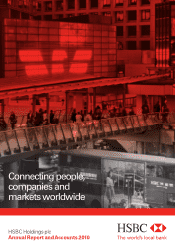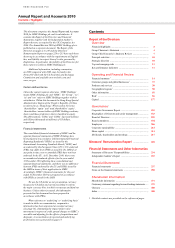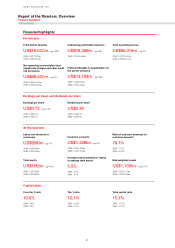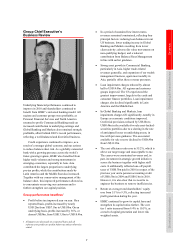HSBC 2010 Annual Report Download - page 9
Download and view the complete annual report
Please find page 9 of the 2010 HSBC annual report below. You can navigate through the pages in the report by either clicking on the pages listed below, or by using the keyword search tool below to find specific information within the annual report.-
 1
1 -
 2
2 -
 3
3 -
 4
4 -
 5
5 -
 6
6 -
 7
7 -
 8
8 -
 9
9 -
 10
10 -
 11
11 -
 12
12 -
 13
13 -
 14
14 -
 15
15 -
 16
16 -
 17
17 -
 18
18 -
 19
19 -
 20
20 -
 21
21 -
 22
22 -
 23
23 -
 24
24 -
 25
25 -
 26
26 -
 27
27 -
 28
28 -
 29
29 -
 30
30 -
 31
31 -
 32
32 -
 33
33 -
 34
34 -
 35
35 -
 36
36 -
 37
37 -
 38
38 -
 39
39 -
 40
40 -
 41
41 -
 42
42 -
 43
43 -
 44
44 -
 45
45 -
 46
46 -
 47
47 -
 48
48 -
 49
49 -
 50
50 -
 51
51 -
 52
52 -
 53
53 -
 54
54 -
 55
55 -
 56
56 -
 57
57 -
 58
58 -
 59
59 -
 60
60 -
 61
61 -
 62
62 -
 63
63 -
 64
64 -
 65
65 -
 66
66 -
 67
67 -
 68
68 -
 69
69 -
 70
70 -
 71
71 -
 72
72 -
 73
73 -
 74
74 -
 75
75 -
 76
76 -
 77
77 -
 78
78 -
 79
79 -
 80
80 -
 81
81 -
 82
82 -
 83
83 -
 84
84 -
 85
85 -
 86
86 -
 87
87 -
 88
88 -
 89
89 -
 90
90 -
 91
91 -
 92
92 -
 93
93 -
 94
94 -
 95
95 -
 96
96 -
 97
97 -
 98
98 -
 99
99 -
 100
100 -
 101
101 -
 102
102 -
 103
103 -
 104
104 -
 105
105 -
 106
106 -
 107
107 -
 108
108 -
 109
109 -
 110
110 -
 111
111 -
 112
112 -
 113
113 -
 114
114 -
 115
115 -
 116
116 -
 117
117 -
 118
118 -
 119
119 -
 120
120 -
 121
121 -
 122
122 -
 123
123 -
 124
124 -
 125
125 -
 126
126 -
 127
127 -
 128
128 -
 129
129 -
 130
130 -
 131
131 -
 132
132 -
 133
133 -
 134
134 -
 135
135 -
 136
136 -
 137
137 -
 138
138 -
 139
139 -
 140
140 -
 141
141 -
 142
142 -
 143
143 -
 144
144 -
 145
145 -
 146
146 -
 147
147 -
 148
148 -
 149
149 -
 150
150 -
 151
151 -
 152
152 -
 153
153 -
 154
154 -
 155
155 -
 156
156 -
 157
157 -
 158
158 -
 159
159 -
 160
160 -
 161
161 -
 162
162 -
 163
163 -
 164
164 -
 165
165 -
 166
166 -
 167
167 -
 168
168 -
 169
169 -
 170
170 -
 171
171 -
 172
172 -
 173
173 -
 174
174 -
 175
175 -
 176
176 -
 177
177 -
 178
178 -
 179
179 -
 180
180 -
 181
181 -
 182
182 -
 183
183 -
 184
184 -
 185
185 -
 186
186 -
 187
187 -
 188
188 -
 189
189 -
 190
190 -
 191
191 -
 192
192 -
 193
193 -
 194
194 -
 195
195 -
 196
196 -
 197
197 -
 198
198 -
 199
199 -
 200
200 -
 201
201 -
 202
202 -
 203
203 -
 204
204 -
 205
205 -
 206
206 -
 207
207 -
 208
208 -
 209
209 -
 210
210 -
 211
211 -
 212
212 -
 213
213 -
 214
214 -
 215
215 -
 216
216 -
 217
217 -
 218
218 -
 219
219 -
 220
220 -
 221
221 -
 222
222 -
 223
223 -
 224
224 -
 225
225 -
 226
226 -
 227
227 -
 228
228 -
 229
229 -
 230
230 -
 231
231 -
 232
232 -
 233
233 -
 234
234 -
 235
235 -
 236
236 -
 237
237 -
 238
238 -
 239
239 -
 240
240 -
 241
241 -
 242
242 -
 243
243 -
 244
244 -
 245
245 -
 246
246 -
 247
247 -
 248
248 -
 249
249 -
 250
250 -
 251
251 -
 252
252 -
 253
253 -
 254
254 -
 255
255 -
 256
256 -
 257
257 -
 258
258 -
 259
259 -
 260
260 -
 261
261 -
 262
262 -
 263
263 -
 264
264 -
 265
265 -
 266
266 -
 267
267 -
 268
268 -
 269
269 -
 270
270 -
 271
271 -
 272
272 -
 273
273 -
 274
274 -
 275
275 -
 276
276 -
 277
277 -
 278
278 -
 279
279 -
 280
280 -
 281
281 -
 282
282 -
 283
283 -
 284
284 -
 285
285 -
 286
286 -
 287
287 -
 288
288 -
 289
289 -
 290
290 -
 291
291 -
 292
292 -
 293
293 -
 294
294 -
 295
295 -
 296
296 -
 297
297 -
 298
298 -
 299
299 -
 300
300 -
 301
301 -
 302
302 -
 303
303 -
 304
304 -
 305
305 -
 306
306 -
 307
307 -
 308
308 -
 309
309 -
 310
310 -
 311
311 -
 312
312 -
 313
313 -
 314
314 -
 315
315 -
 316
316 -
 317
317 -
 318
318 -
 319
319 -
 320
320 -
 321
321 -
 322
322 -
 323
323 -
 324
324 -
 325
325 -
 326
326 -
 327
327 -
 328
328 -
 329
329 -
 330
330 -
 331
331 -
 332
332 -
 333
333 -
 334
334 -
 335
335 -
 336
336 -
 337
337 -
 338
338 -
 339
339 -
 340
340 -
 341
341 -
 342
342 -
 343
343 -
 344
344 -
 345
345 -
 346
346 -
 347
347 -
 348
348 -
 349
349 -
 350
350 -
 351
351 -
 352
352 -
 353
353 -
 354
354 -
 355
355 -
 356
356 -
 357
357 -
 358
358 -
 359
359 -
 360
360 -
 361
361 -
 362
362 -
 363
363 -
 364
364 -
 365
365 -
 366
366 -
 367
367 -
 368
368 -
 369
369 -
 370
370 -
 371
371 -
 372
372 -
 373
373 -
 374
374 -
 375
375 -
 376
376 -
 377
377 -
 378
378 -
 379
379 -
 380
380 -
 381
381 -
 382
382 -
 383
383 -
 384
384 -
 385
385 -
 386
386 -
 387
387 -
 388
388 -
 389
389 -
 390
390 -
 391
391 -
 392
392 -
 393
393 -
 394
394 -
 395
395 -
 396
396
 |
 |

7
Overview Operating & Financial Review Governance Financial Statements Shareholder Information
Group Chief Executive’s
Business Review
Underlying financial performance continued to
improve in 2010 and shareholders continued to
benefit from HSBC’s universal banking model. All
regions and customer groups were profitable, as
Personal Financial Services and North America
returned to profit. Commercial Banking made an
increased contribution to underlying earnings and
Global Banking and Markets also remained strongly
profitable, albeit behind 2009’s record performance,
reflecting a well-balanced and diversified business.
Credit experience continued to improve, as a
result of a stronger global economy and our actions
to reduce balance sheet risk. As a globally-connected
bank with a growing presence across the world’s
faster-growing regions, HSBC also benefited from
higher trade volumes and strong momentum in
emerging economies, especially in Asia. Asia
contributed the largest proportion to underlying
pre-tax profits, while the contributions made by
Latin America and the Middle East also increased.
Together with our conservative management of the
balance sheet, this improved performance allowed us
to concentrate on serving our customers and to
further strengthen our capital position.
Group performance headlines1
• Profit before tax improved year on year. On a
reported basis, profits increased by nearly
US$12bn from US$7.1bn to US$19bn. On an
underlying basis, profits increased by 36%, or
almost US$5bn, from US$13.5bn to US$18.4bn.
1 All figures are discussed on a reported basis and all
references to profits are profits before tax unless otherwise
stated.
• In a period of sustained low interest rates,
revenues remained constrained, reflecting four
principal factors: reducing loan balances in our
US business; lower trading income in Global
Banking and Markets resulting from lower
client activity; adverse fair value movements on
non-qualifying hedges; and a reduced
contribution from Balance Sheet Management
in line with earlier guidance.
• Strong asset growth in Commercial Banking,
particularly in Asia, higher trade-related
revenues generally, and expansion of our wealth
management business, again most notably in
Asia, partially offset these revenue pressures.
• Loan impairment charges reduced by almost
half to US$14.0bn. All regions and customer
groups improved. The US experienced the
greatest improvement, largely in the cards and
consumer finance portfolios. Loan impairment
charges also declined significantly in Latin
America and the Middle East.
• In Global Banking and Markets, loan
impairment charges fell significantly, notably in
Europe as economic conditions improved.
Credit risk provisions reduced by US$1bn to
US$0.4bn in the available-for-sale asset-backed-
securities portfolios due to a slowing in the rate
of anticipated losses on underlying assets, in
line with previous guidance. The associated
available for sale reserve declined to US$6.4bn
from US$12.2bn.
• The cost efficiency ratio rose to 55.2%, which is
above our target range and unacceptable to me.
The causes were constrained revenues and, in
part, investment in strategic growth initiatives
across the business together with higher staff
costs. It additionally reflected one-off payroll
taxes of US$0.3bn paid in 2010 in respect of the
previous year and a pension accounting credit
of US$0.5bn in 2009 and US$0.1bn in 2010.
However, it is also clear that we need to re-
engineer the business to remove inefficiencies.
• Return on average total shareholders’ equity
rose from 5.1% to 9.5%, reflecting increased
profit generation during the year.
• HSBC continued to grow its capital base and
strengthen its capital ratios further. The core
tier 1 ratio increased from 9.4% to 10.5%, as
a result of capital generation and lower risk
weighted assets.
